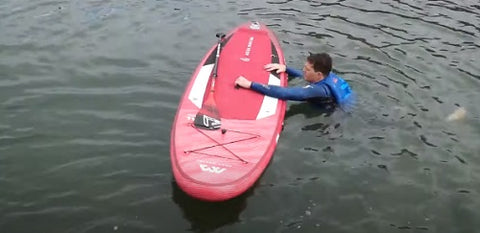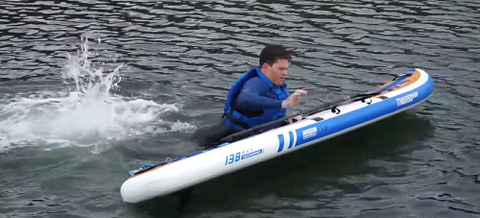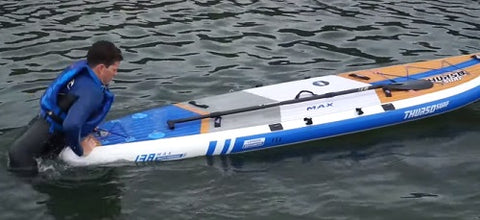Different Ways to Get Back on Your Inflatable Paddle Board After Falling In
For a paddler, falling in is basically inevitable. At some point, you are bound to fall into the water. So it’s important to know how to climb back onto your board, which is not that easy as most people would think. Below are several ways for you to climb back onto your board after falling off your board. If you are struggling to get back onto your board, be sure to check this out.
1. Climb back on from the side
First put your paddle on top of the board and in a position that won’t get in your way when you try and climb back onto your board. you can try putting it on the far side of where you are climbing back on from.
The first and most common way of climbing back onto your board is to use the main center carry handle to pull yourself up. It’s well-positioned and easy to grab. But it’s not the only handle you can use. If your board has other handles in other positions, try using them as well and it might turn out better than the center handle. But here we will only talk about using the center handle. Whilst holding onto the center handle with one hand, kick your feet to push yourself out of the water whilst pulling yourself up using the handle. After getting part of your upper body on the board, reach over to the other rail with your free hand and grab it to keep pulling yourself onto the board. After getting your upper body on the board competely, swing your legs up onto the board.

If you find this difficult, chances are you are doing it wrong. Some might have their feet under the baord which makes it impossible to kick or use their legs to their advantage. This is quite common when facing upwind or when there is some current under the board which take your legs up and under them.
You can think of this technique as getting out of a swimming pool without using the steps.
A PFD will make climbing back on the board using this method a little trickier, especially if you are wearing a bulky one. So if you are wanting to wear a PFD for increased confidence, choose a slimline one without any buckles or pockets to the front. Or if you are wearing a PFD less for confidence and more for the emergency use such as you are experienced paddleboarder and you are going out for longer touring adventures, maybe consider an inflatable waist belt PFD instead, which is a lot less bulky and therefore, less likely to get in your way. If it’s in the front you can always spin it around to the back so it wont’ get in your way when you paddle or try to climb back on the board.
Use a thinner board
Both inflatable paddle boards and hardboards come in different thicknesses. Thicker boarsd float higher out of the water which makes it harder for you to get back up and onto. So it’s worth considering the thickness of your board if you are having a hard time trying to climb back on your board. Maybe try a 5-inch thick rather than a 6-inch board to see if that does help.

It might not seem like much of a difference but it really can make a huge difference, especially when you compare then side by side. A thinner inflatable board means it’s less high to climb up onto and easier to push down and sink down to get your body up and onto the board.
Pick a board with less fittings on the sides
Another thing to consider with your equipment is to choose a board with less fittings near the side of the board. For example, a handle, D-rings, attachments, etc. Those can all get in your way when you try to slide up onto the board and you may get caught on them.
One of the biggest trips is to make sure you are facing downwind, or in other words, have the wind on your back. This will ensure the board is not being blown away towards you and therefore your legs will be free to kick and it will make it a lot easier for you to pull yourself up.
2. Climb back on from the tail of the board
Some paddlers would try to climb back on the board from the tail. By sinking the tail a little, you can sometimes find it easier to get your body on top of the board. What’s great about climbing back from the tail is that because the tail is narrower in the width, you can easily grab the two sides of the board and pull yourself up. If you find the first method to be too difficult, try using this method and it might turn out to be much better than the first one.

Find someone to help
If you are paddling with others, another really great way to help you back up onto the board is to get them to hold the opposite rail in the water, so you are really able to use your arms and use your body weight on one side of the rail to get yourself up and onto the board. Sometimes paddlers struggle to climb back on their board because the board keep flipping, so it’s always good to have someone else on that side.
There’s another rescue technique that we use as well where we flip the board over, we get the person’s arm resting over the side of the board or over the top of the board, and then we flip the board over. However, this can be difficult and you really need to know what you are doing out there in the water. So it’s really good to practice this a few times if you are paddling with others.
If you are just learning how to paddle board, then hopefully you’ll be paddling near to the shore. If you are quite close to the shore and you think you might be able to stand, swimming back in toward that shallower water will really help you because then you are able to stand up on the ground and use your feet to get yourself back up and onto the board.
The most important tip is to remain calm no matter what happens. Try not to panic or rush, take your time. Also, remember to put on a leash to ensure that your board is always within close reach.










